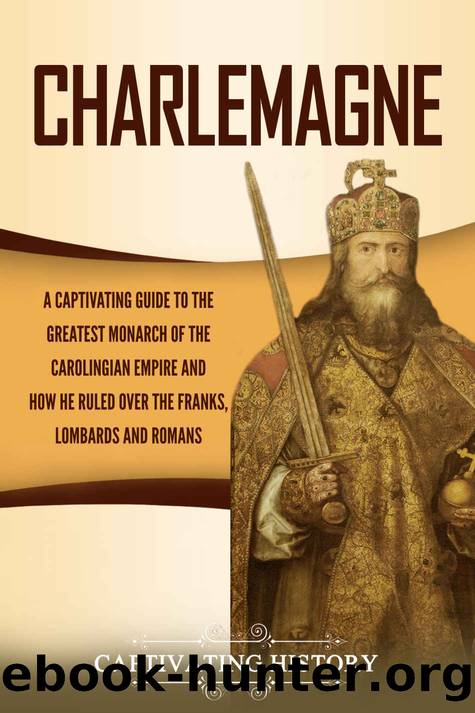Charlemagne: A Captivating Guide to the Greatest Monarch of the Carolingian Empire and How He Ruled over the Franks, Lombards, and Romans by Captivating History

Author:Captivating History [History, Captivating]
Language: eng
Format: azw3
Published: 2020-07-10T00:00:00+00:00
Chapter 6 â The Burning of the Sacred Places
Illustration III: Ary Schefferâs 19th-century depiction of Charlemagne accepting the submission of Widukind at Paderborn.
September 778 must have been one of the hardest times of Charlemagneâs life. A frigid French winter descended upon his army, which was still a long way from home, and they had already traveled the 500 miles from Roncevaux to Auxerre. If Charlemagne was heading to his usual seat at Aachen, he still had 300 miles to go; even if he was going to Paris, he still had 100 miles left to travel. It must have seemed like a very long way to the disheartened Frankish king whoâd just buried many of his best commanders and closest friends. He had also just suffered his first and only major defeat.
At Auxerre, Charlemagne began to demobilize his giant army, and we can only imagine that his thoughts were set on the comforts of home. Heâd been ruling for ten years and spent most of them in active warfare. But his warring days were far from over. In fact, they were just beginning, and when Charlemagne was at Auxerre, he learned that his fighting for the year was not yet done. Word came to him from the northeast. The Saxons were revoltingâagain.
The Saxons
This wild, warlike Germanic tribe had been a prolific and intimidating people for centuries. Originating along the North Sea coasts of Germany, the Netherlands, and Denmark, they had threatened all kinds of European powers, from the ancient Romans to the Vikings, and now, they were becoming a thorn in the side of the Carolingian Empire.
Sadly, little is really known about the Saxons and their culture, and their side of historyâs story has seldom been told. We know that they were named Saxons after their choice of weapon: the seax, a brutal, short, nimble sword that often spilled the guts of those who considered themselves more civilized, and at close quarters to boot. They spoke a Teutonic language that would become the precursor to the English youâre reading right now. Unfortunately for us, the Saxons did not write. They were an illiterate people, and so, their only surviving contemporary histories are those of their enemies.
The earliest records of the Saxons, as with many of these tribes that had no use for the written word, belong to the ancient Romans. As the Roman Empire expanded into Gaul, the Saxons resisted strenuously, and they would be a thorn in the Romansâ side until the very end of the empire. Britannica (modern-day Great Britain) was a hotbed for Roman-Saxon conflict, as the Saxons were expansionists as well. Childeric I, the Merovingian king who fought Attila the Hun alongside the Romans, would be one of many Frankish kings to fight the Saxons. He was a part of one of the last Roman armies to wage war on this fierce tribe.
The Saxons also practiced paganism, worshiping a variety of deities related to the earth and other parts of their surroundings. There are also some parallels with the Norse gods.
Download
This site does not store any files on its server. We only index and link to content provided by other sites. Please contact the content providers to delete copyright contents if any and email us, we'll remove relevant links or contents immediately.
| Africa | Americas |
| Arctic & Antarctica | Asia |
| Australia & Oceania | Europe |
| Middle East | Russia |
| United States | World |
| Ancient Civilizations | Military |
| Historical Study & Educational Resources |
Magic and Divination in Early Islam by Emilie Savage-Smith;(1500)
Ambition and Desire: The Dangerous Life of Josephine Bonaparte by Kate Williams(1346)
Bohemians, Bootleggers, Flappers, and Swells: The Best of Early Vanity Fair by Bohemians Bootleggers Flappers & Swells- The Best of Early Vanity Fair (epub)(1344)
Papillon by Henry Charrière(1310)
Twelve Caesars by Mary Beard(1258)
Operation Vengeance: The Astonishing Aerial Ambush That Changed World War II by Dan Hampton(1137)
What Really Happened: The Death of Hitler by Robert J. Hutchinson(1131)
London in the Twentieth Century by Jerry White(1114)
Time of the Magicians by Wolfram Eilenberger(1089)
The Japanese by Christopher Harding(1086)
Twilight of the Gods by Ian W. Toll(1084)
Lenin: A Biography by Robert Service(1045)
The Devil You Know by Charles M. Blow(985)
A Social History of the Media by Peter Burke & Peter Burke(938)
Freemasons for Dummies by Hodapp Christopher;(923)
Napolean Hill Collection by Napoleon Hill(903)
Henry III by David Carpenter;(892)
The Churchill Complex by Ian Buruma(884)
The Rise and Triumph of the Modern Self by Unknown(880)
